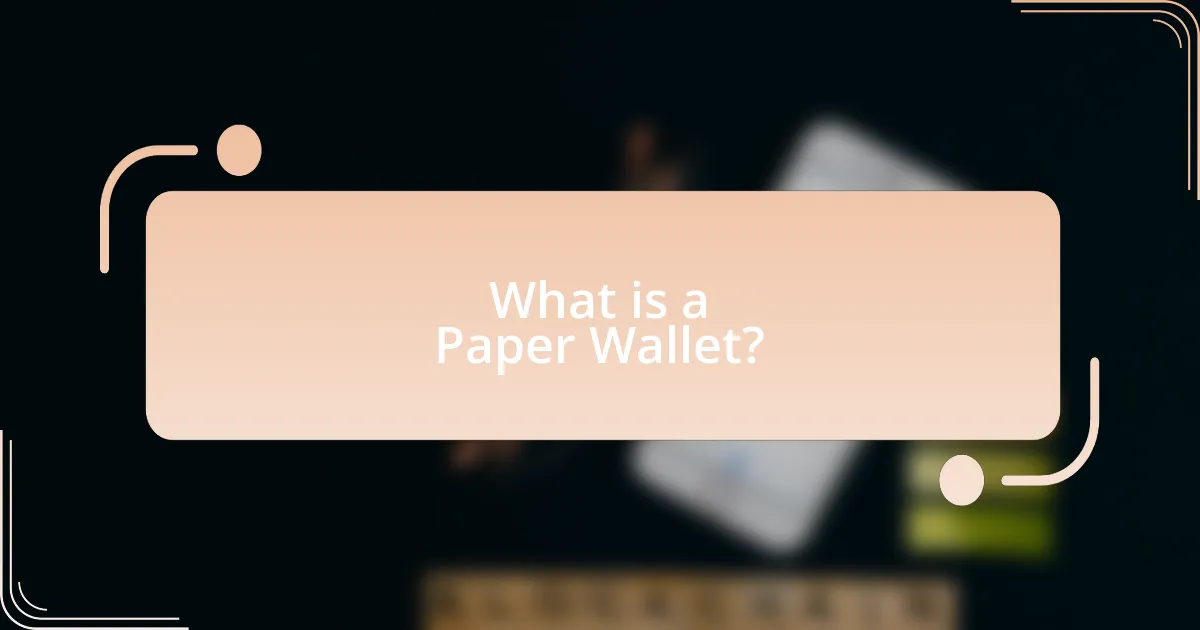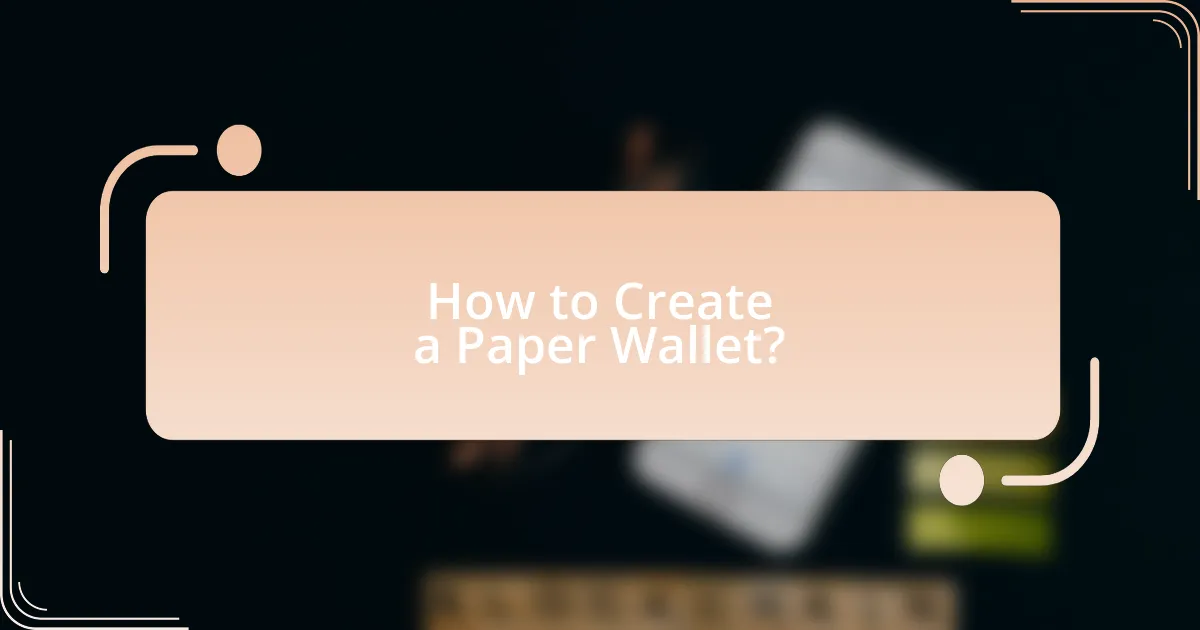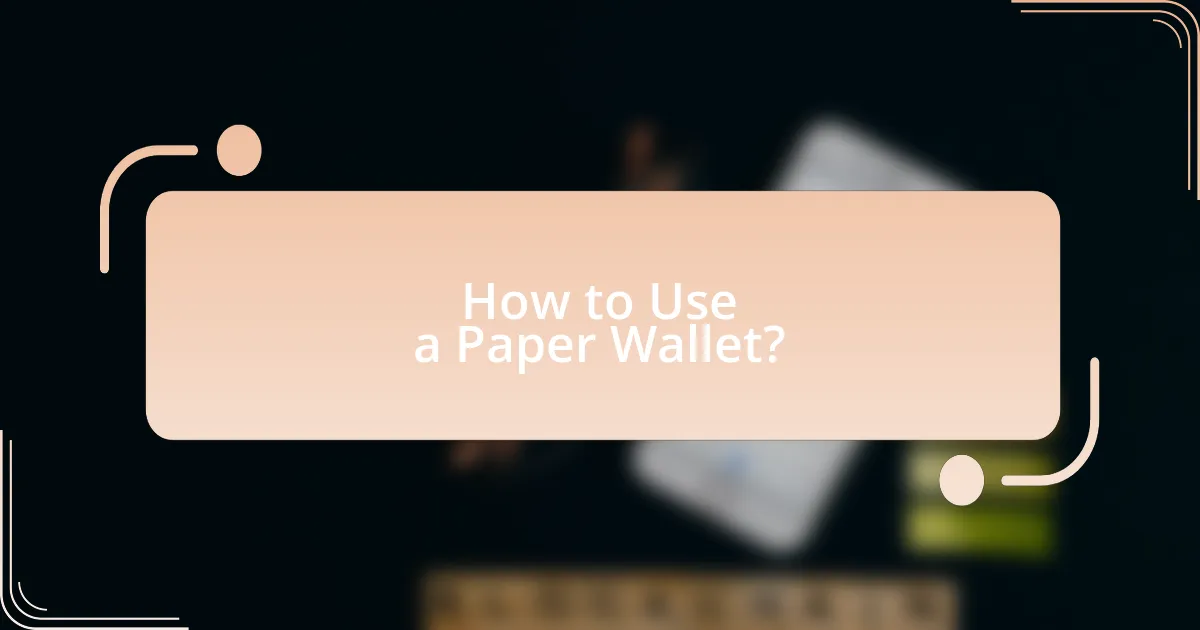A paper wallet is a secure method for storing cryptocurrencies offline, consisting of a physical document that contains a user’s public and private keys. This article provides a comprehensive guide on how to create, use, and manage a paper wallet, detailing the steps involved in generating a wallet, the essential components required, and the advantages of this cold storage solution. It also covers best practices for maintaining security, precautions to take when using a paper wallet, and common mistakes to avoid, ensuring users can effectively safeguard their digital assets.

What is a Paper Wallet?
A paper wallet is a physical document that contains a cryptocurrency address and its corresponding private key, allowing users to store their digital assets offline. This method enhances security by protecting the keys from online threats, as they are not stored on a computer or server. Paper wallets are generated using secure tools that create a unique address and key pair, which can be printed out and kept in a safe place. The effectiveness of paper wallets in safeguarding cryptocurrencies is supported by their offline nature, reducing the risk of hacking and unauthorized access.
How does a Paper Wallet work?
A paper wallet works by securely storing cryptocurrency private keys and public addresses on a physical piece of paper. This method allows users to generate a wallet offline, minimizing the risk of hacking or online theft. The private key, which is essential for accessing and managing the cryptocurrency, is printed in a QR code format, making it easy to scan for transactions. Additionally, since the wallet is not connected to the internet, it is considered a cold storage solution, providing enhanced security against cyber threats.
What are the key components of a Paper Wallet?
The key components of a paper wallet are the public key, private key, and QR codes for both keys. The public key allows others to send cryptocurrency to the wallet, while the private key is essential for accessing and managing the funds stored in the wallet. QR codes facilitate easy scanning and entry of these keys for transactions. Each component is crucial for the functionality and security of the paper wallet, ensuring that users can safely store and access their cryptocurrency.
How is a Paper Wallet different from other wallet types?
A paper wallet is different from other wallet types primarily because it is a physical document that contains a user’s public and private keys printed on it, making it a cold storage solution. Unlike software wallets, which are stored on devices and can be vulnerable to hacking, or hardware wallets that require specific devices to access, a paper wallet is immune to online threats since it is not connected to the internet. This method of storing cryptocurrency keys is considered highly secure, as long as the paper is kept safe from physical damage or loss.
What are the advantages of using a Paper Wallet?
The advantages of using a paper wallet include enhanced security, offline storage, and ease of use. Paper wallets store cryptocurrency private keys in a physical format, making them immune to online hacking attempts. This offline nature significantly reduces the risk of theft associated with digital wallets. Additionally, paper wallets are straightforward to create and manage, requiring only a printer and a secure environment to generate and print the wallet. These factors contribute to their popularity among users seeking a secure method for storing cryptocurrencies.
Why is security a major benefit of a Paper Wallet?
Security is a major benefit of a paper wallet because it stores cryptocurrency offline, significantly reducing the risk of hacking. Unlike digital wallets that are connected to the internet and vulnerable to cyber attacks, paper wallets generate and store private keys on a physical medium, making them immune to online threats. This offline storage method ensures that the private keys are not exposed to malware or phishing attempts, which are common in digital environments. Additionally, the use of a paper wallet allows users to maintain complete control over their assets without relying on third-party services, further enhancing security.
How does a Paper Wallet provide offline storage?
A paper wallet provides offline storage by allowing users to generate and print their cryptocurrency private keys and public addresses on a physical piece of paper. This method ensures that the keys are not stored on any digital device, which significantly reduces the risk of hacking or malware attacks. The paper wallet remains secure as long as it is kept in a safe location, preventing unauthorized access to the cryptocurrency associated with the printed keys.

How to Create a Paper Wallet?
To create a paper wallet, first generate a new Bitcoin address and its corresponding private key using a secure, offline wallet generator like Bitaddress.org or WalletGenerator.net. These tools allow users to create a wallet without being connected to the internet, minimizing the risk of exposure to malware or hacking. After generating the address and key, print the wallet on a piece of paper, ensuring that both the QR code and the alphanumeric strings are clearly visible. It is crucial to store the printed paper wallet in a safe place, as anyone with access to the private key can control the associated funds.
What steps are involved in generating a Paper Wallet?
To generate a paper wallet, follow these steps: First, select a reputable paper wallet generator website, such as Bitaddress.org or WalletGenerator.net. Next, ensure your computer is offline to enhance security. Then, generate a new wallet by moving your mouse or typing random characters to create randomness. After the wallet is generated, print the wallet containing the public and private keys. Finally, store the printed wallet in a secure location, ensuring it is protected from physical damage and unauthorized access. These steps ensure the secure creation and storage of cryptocurrency keys.
What tools or websites can be used to create a Paper Wallet?
To create a paper wallet, tools and websites such as Bitaddress.org, WalletGenerator.net, and MyEtherWallet can be utilized. Bitaddress.org allows users to generate Bitcoin paper wallets offline, ensuring security from online threats. WalletGenerator.net supports multiple cryptocurrencies and also offers an offline option for wallet creation. MyEtherWallet is specifically designed for Ethereum and allows users to create paper wallets securely. Each of these platforms provides a straightforward interface for generating and printing paper wallets, ensuring that users can safely store their cryptocurrency.
How do you ensure the security of the creation process?
To ensure the security of the creation process for a paper wallet, it is essential to generate the wallet offline using a secure, trusted device. This minimizes exposure to online threats such as malware or hacking attempts. Utilizing a reputable wallet generator, preferably one that allows for offline use, further enhances security by preventing unauthorized access during the wallet creation. Additionally, verifying the integrity of the wallet generator through checksums or hashes ensures that the software has not been tampered with.
What information should be included on a Paper Wallet?
A paper wallet should include the public key and the private key associated with the cryptocurrency. The public key allows others to send cryptocurrency to the wallet, while the private key is necessary for accessing and spending the funds. It is crucial to ensure that both keys are printed clearly and securely, as losing the private key means losing access to the funds. Additionally, including a QR code for both keys can facilitate easier transactions.
What are the essential keys to print on a Paper Wallet?
The essential keys to print on a paper wallet are the public key and the private key. The public key allows others to send cryptocurrency to the wallet, while the private key is necessary for accessing and managing the funds stored in that wallet. Printing both keys ensures that the user has a physical copy for secure access. The importance of these keys is underscored by the fact that losing the private key results in the permanent loss of access to the funds, as there is no recovery method for cryptocurrency without it.
How can you add extra security features to your Paper Wallet?
To add extra security features to your paper wallet, you can implement several strategies. First, use a secure offline computer to generate your wallet, ensuring that it is not connected to the internet during the process. This minimizes the risk of malware or hacking. Second, print your paper wallet on high-quality, non-digital paper to prevent easy duplication or damage. Third, store the paper wallet in a safe or a safety deposit box to protect it from physical theft or environmental damage. Additionally, consider using a tamper-evident seal on the wallet to detect any unauthorized access. These methods enhance the security of your paper wallet by addressing both digital and physical vulnerabilities.

How to Use a Paper Wallet?
To use a paper wallet, first, generate a paper wallet using a secure wallet generator, ensuring it is offline to prevent exposure to malware. After generating the wallet, print it out, which will display your public and private keys. The public key allows you to receive funds, while the private key is necessary for accessing and spending those funds. To use the paper wallet, transfer cryptocurrency to the public key by providing it to the sender. When you want to spend the cryptocurrency, import or sweep the private key into a software wallet, which will allow you to access your funds. This method is secure as long as the paper wallet is stored safely and not exposed to unauthorized access.
How do you access funds stored in a Paper Wallet?
To access funds stored in a paper wallet, you must import or sweep the private key into a compatible cryptocurrency wallet. This process involves using a digital wallet application that supports the cryptocurrency associated with the paper wallet. For example, if the paper wallet contains Bitcoin, you can use wallets like Electrum or Mycelium.
Importing the private key allows you to access the funds directly, while sweeping transfers the funds to a new wallet address, ensuring the original paper wallet is no longer used. This method is recommended for security reasons, as it minimizes the risk of exposing the private key to potential theft.
What steps are needed to import a Paper Wallet into a software wallet?
To import a paper wallet into a software wallet, first, access the software wallet application that supports paper wallet imports. Next, locate the option to import or sweep a wallet, which is typically found in the settings or wallet management section. Then, enter the private key or scan the QR code from the paper wallet using the software wallet’s interface. Finally, confirm the transaction to complete the import process, ensuring that the funds from the paper wallet are now accessible in the software wallet. This method is widely used as it allows users to transfer funds securely from a paper wallet to a more user-friendly software wallet environment.
How can you safely transfer funds from a Paper Wallet?
To safely transfer funds from a paper wallet, first, import or sweep the private key associated with the paper wallet into a secure software wallet. This process involves using a reputable wallet application that supports private key imports, ensuring that the software is downloaded from an official source to avoid malware. After importing the private key, initiate a transaction to send the funds to a new address, preferably one generated by a different wallet for enhanced security. This method minimizes the risk of exposing the private key to potential threats, as the funds are moved to a more secure environment.
What precautions should you take when using a Paper Wallet?
When using a paper wallet, ensure to generate it in a secure environment, preferably offline, to prevent exposure to malware or hacking attempts. This involves using a trusted computer that is free from viruses and connecting to the internet only when necessary. Additionally, print the wallet using a secure printer and avoid saving any digital copies to prevent unauthorized access.
Store the paper wallet in a safe location, such as a safe deposit box, to protect it from physical damage or theft. It is also crucial to create multiple copies of the paper wallet and store them in different secure locations to mitigate the risk of loss. Lastly, avoid sharing the wallet’s private key with anyone, as this could lead to unauthorized access to your funds.
How do you protect your Paper Wallet from physical damage?
To protect your paper wallet from physical damage, store it in a waterproof and tear-resistant sleeve or case. This method safeguards against moisture, dirt, and physical wear, ensuring the integrity of the printed information. Additionally, keeping the wallet in a secure location, such as a safe or a locked drawer, minimizes the risk of loss or theft. According to the Bitcoin Whitepaper, maintaining the security of private keys is crucial for safeguarding digital assets, and protecting the physical medium is a fundamental aspect of this security.
What should you do if your Paper Wallet is lost or damaged?
If your paper wallet is lost or damaged, you should immediately check if you have a backup of the private keys or recovery phrase associated with it. If you possess this backup, you can restore access to your funds by importing the keys into a compatible wallet software. According to the best practices in cryptocurrency management, maintaining a secure backup is crucial, as losing access to the private keys typically results in permanent loss of the associated funds.
What are common mistakes to avoid when using a Paper Wallet?
Common mistakes to avoid when using a paper wallet include failing to generate the wallet in a secure environment, neglecting to back up the wallet properly, and not storing the paper wallet in a safe location. Generating a paper wallet on an insecure device can expose private keys to malware, while inadequate backups can lead to loss of access if the wallet is damaged or lost. Additionally, storing the paper wallet in an easily accessible or vulnerable location increases the risk of theft or damage.
How can you ensure you don’t lose access to your funds?
To ensure you don’t lose access to your funds, securely store your paper wallet in a safe location, such as a fireproof and waterproof safe. This method protects against physical damage and theft, which are common risks for paper wallets. Additionally, create multiple copies of your paper wallet and store them in different secure locations to mitigate the risk of loss due to accidents or disasters. According to a study by the University of Cambridge, 20% of Bitcoin users have lost access to their funds due to poor storage practices, highlighting the importance of secure storage methods.
What security oversights should you be aware of?
Security oversights to be aware of when using a paper wallet include improper storage, exposure to physical damage, and failure to verify the wallet’s authenticity. Improper storage can lead to loss or theft; for instance, keeping the wallet in an easily accessible location increases the risk of it being found by unauthorized individuals. Exposure to physical damage, such as water or fire, can render the wallet unusable, resulting in the permanent loss of funds. Additionally, failing to verify the wallet’s authenticity can lead to using a counterfeit wallet, which may compromise security and lead to theft of funds. These oversights highlight the importance of secure handling and verification processes when managing a paper wallet.
What are best practices for managing a Paper Wallet?
The best practices for managing a paper wallet include securely generating the wallet offline, storing it in a safe location, and regularly backing up the information. Generating a paper wallet offline minimizes the risk of exposure to malware or online threats, ensuring that private keys remain secure. Storing the paper wallet in a safe, such as a safe deposit box or a fireproof safe, protects it from physical damage or theft. Additionally, backing up the wallet information by creating multiple copies and storing them in different secure locations helps prevent loss due to damage or misplacement. These practices are essential for maintaining the security and accessibility of cryptocurrency assets stored in a paper wallet.
How often should you check the status of your Paper Wallet?
You should check the status of your paper wallet periodically, ideally every few months. Regular checks ensure that you are aware of any changes in the cryptocurrency market and can confirm that your funds remain secure. Since paper wallets are offline storage solutions, they are not susceptible to online threats, but verifying the status helps you stay informed about your assets and any potential issues that may arise, such as changes in wallet compatibility or updates in the cryptocurrency network.
What tips can help you maintain the security of your Paper Wallet?
To maintain the security of your Paper Wallet, store it in a safe, dry, and secure location, such as a safe deposit box or a fireproof safe. This prevents physical damage and unauthorized access. Additionally, avoid sharing images or details of your Paper Wallet online, as this can expose your private keys to potential theft. Using a secure method to generate your Paper Wallet, such as an offline computer or a trusted hardware wallet, further enhances security by minimizing exposure to malware. Regularly check the integrity of your Paper Wallet and consider creating multiple copies stored in different secure locations to mitigate the risk of loss.